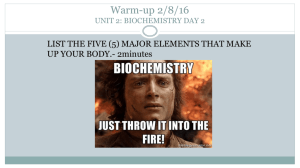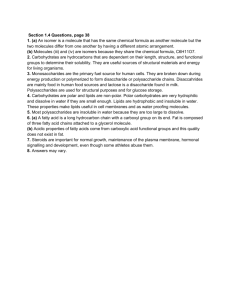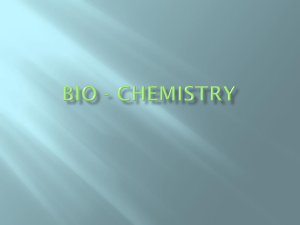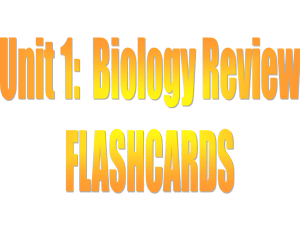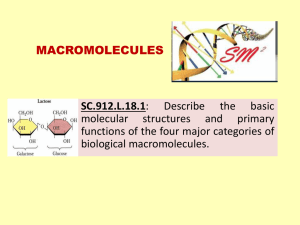Day 2 Carbs and Lipids
advertisement
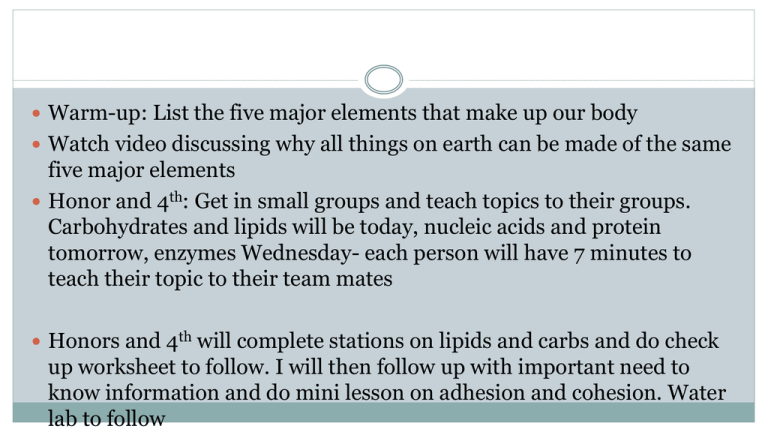
Warm-up: List the five major elements that make up our body Watch video discussing why all things on earth can be made of the same five major elements Honor and 4th: Get in small groups and teach topics to their groups. Carbohydrates and lipids will be today, nucleic acids and protein tomorrow, enzymes Wednesday- each person will have 7 minutes to teach their topic to their team mates Honors and 4th will complete stations on lipids and carbs and do check up worksheet to follow. I will then follow up with important need to know information and do mini lesson on adhesion and cohesion. Water lab to follow CATALYST UNIT 2: BIOCHEMISTRY DAY 1 LIST THE FIVE (5) MAJOR ELEMENTS THAT MAKE UP YOUR BODY Umm…why are we learning about chemistry in biology? Why are we learning about Chemistry??? 5 elements make up over 90% of your body! C, H, N, O, P (Carbon, Hydrogen, Nitrogen, Oxygen, Phosphorous) BECAUSE….. Every biological process is part of a chemical reaction! All of the energy we need depends on chemical reactions! Basic Chemistry REMINDERS… Chemical symbols are used to represent each element. Found on the Periodic Table Basic Chemistry REMINDERS… Compounds are combinations of 2 or more elements. Biochemistry Study of the chemicals necessary for living things. Also called Organic Chemistry. Involves the element carbon (C) Organic vs. Inorganic Organic Molecules Contain carbon, hydrogen and oxygen atoms together Inorganic Molecules Don’t contain carbon, hydrogen and oxygen together Make up living things Make up nonliving things Molecules that play an important Molecules that also play an role in living things Most important organic molecule is glucose important role in living things Most important inorganic molecule is water. Biochemistry Terms to Know: Monomer – the smallest unit of a substance (the building block) Example: like one Lego block Polymer – many monomers linked together to make a large structure; also called macromolecules (many repeating subunits linked together) Example: Lego blocks put together to make a Lego house Biochemistry Types of Organic Molecules (Macromolecules) 1. Carbohydrates 2. Lipids 3. Proteins 4. Nucleic Acids CARBOHYDRATES Function: to store and release QUICK energy If the energy is not used, it gets stored as FAT (or LIPIDS) Monomer = monosaccharide (one unit of sugar) Examples: Glucose & Fructose Polymer = Polysaccharide (many Example: Starches units of sugar) The ATOMS & RATIO Made of CARBON (C), HYDROGEN (H), and OXYGEN (O) These atoms are found in a special ration: 1:2:1 ratio (Example: C6H12O6) It LOOKS Like… Monomer Pictures Polymer It is IMPORTANT because… It is made by PRODUCERS in PHOTOSYNTHESIS GLUCOSE is the sugar made by plants during photosynthesis. Animals use this glucose to help create cellular energy (ATP) TESTS FOR SUGAR: Benedict’s Solution To help remember this: BEN LIKES SUGAR! FOR STARCH: Iodine To help remember this: I DINE ON STARCH! Monosaccharides Monomer = 1 Unit of SUGAR Examples: Glucose Fructose Monomers are SIMPLE carbohydrates They give you quick energy and are typically not very healthy Example: sugars found in candy bars! POLYSACCHARIDES Polymer = Many Units of SUGAR Examples: Starch sugars in plants (made of many repeating glucose molecules) Glycogen energy storage in animal muscle Cellulose found in plant cell walls; animals can not digest Polysaccharides are COMPLEX carbohydrates They are better for you than SIMPLE carbohydrates Examples: brown rice, potatoes, pasta, bread They typically END in… -OSE Example: glucOSE, fructOSE, lactOSE What happens when they are not used? They turn into FAT Properties of Water - Observations Cohesion: Water is attracted to water Adhesion: Water is attracted to other substances *cohesion and adhesion are the "stickiness" that water molecules have for each other and for other substances *surface tension is the result of the tendency of water molecules to attract one another In a water molecule, the two hydrogen atoms align themselves along one side of the oxygen atom, with the result being that the oxygen side has a slight negative charge and the side with the hydrogen atoms has a slight positive charge. Thus when the positive side on one water molecule comes near the negative side of another water molecule, they attract each other and form a hydrogen bond.

